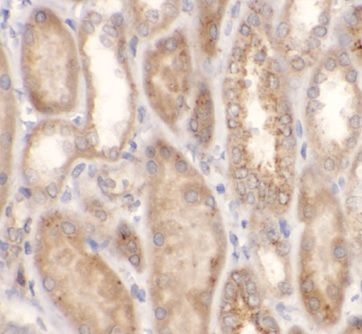Products
PPARGC1A antibody
| Synonyms: | Peroxisome proliferator-activated receptor gamma coactivator 1-alpha (PGC-1-alpha antibody, PPAR-gamma coactivator 1-alpha antibody, PPARGC-1-alpha)|Ligand effect modulator 6|PPARGC1A|LEM6|PGC1|PGC1A|PPARGC1 antibody | ||
| Catalogue No.: | FNab06351 | Reactivity: | Human, Mouse, Rat |
| Host: | Rabbit | Tested Application: | ELISA, WB, IHC |
| Clonality: | polyclonal | Isotype: | IgG |
| Size | Price |
|---|---|
| 100µg | Inquiry |
- SPECIFICATIONS
- CITATIONS
- FIGURES
- CONDITIONS
- FAQS
- Product Name
- PPARGC1A antibody
- Catalogue No.
- FNab06351
- Size
- 100μg
- Form
- liquid
- Purification
- Immunogen affinity purified
- Purity
- ≥95% as determined by SDS-PAGE
- Clonality
- polyclonal
- Isotype
- IgG
- Storage
- PBS with 0.02% sodium azide and 50% glycerol pH 7.3, -20℃ for 12 months(Avoid repeated freeze / thaw cycles.)
- Immunogen
- peroxisome proliferator-activated receptor gamma, coactivator 1 alpha
- Alternative Names
- Peroxisome proliferator-activated receptor gamma coactivator 1-alpha (PGC-1-alpha antibody, PPAR-gamma coactivator 1-alpha antibody, PPARGC-1-alpha)|Ligand effect modulator 6|PPARGC1A|LEM6|PGC1|PGC1A|PPARGC1 antibody
- UniProt ID
- Q9UBK2
- Observed MW
- 110 kDa
- Tested Applications
- ELISA, WB, IHC
- Recommended dilution
- WB: 1:500-1:2000; IHC: 1:20-1:200
 HeLa cells were subjected to SDS PAGE followed by western blot with FNab06351(PGC1a Antibody) at dilution of 1:1000
HeLa cells were subjected to SDS PAGE followed by western blot with FNab06351(PGC1a Antibody) at dilution of 1:1000
 Immunohistochemistry of paraffin-embedded mouse kidney tissue slide using FNab06351(PGC1a Antibody) at dilution of 1:100
Immunohistochemistry of paraffin-embedded mouse kidney tissue slide using FNab06351(PGC1a Antibody) at dilution of 1:100
- Background
- PPARGC1A, also named as Peroxisome proliferator-activated receptor gamma coactivator 1-alpha, is a 798 amino acid protein, which Contains 1 RRM(RNA recognition motif) domain and localizes in the nucleus. PPARGC1A is transcriptional coactivator for steroid receptors and nuclear receptors. PPARGC1A can regulate key mitochondrial genes that contribute to the program of adaptive thermogenesis and plays an essential role in metabolic reprogramming in response to dietary availability through coordination of the expression of a wide array of genes involved in glucose and fatty acid metabolism.
- Journal:
- Frontiers in Oncology
- Author:
- Departamento de Bioquímica, Instituto Nacional de Cardiología, Ciudad de México, Mexico
- Cited Date:
- 2023-05-12
- Product:
- Journal:
- PLOS ONE
- Cited Date:
- 2023-04-14
- Product:
- Journal:
- World Journal of Traditional Chinese Medicine
- Author:
- Acupuncture and Moxibustion Massage Teaching and Research Office, College of Traditional Chinese Medicine, Binzhou Medical University, Yantai, Shandong, China
- Cited Date:
- 2025-12-26
- Product:
How many times can antibodies be recycled?
First, usually it's not suggested to recycle antibodies. After use, buffer system of antibodies has changed. The storage condition of recycled antibodies for different customers also varies. Thus, the performance efficiency of recycled antibodies can’t be guaranteed. Besides, FineTest ever conducted the antibody recycling assay. Assay results show recycling times of different antibodies also varies. Usually, higher antibody titer allows more repeated use. Customers can determine based on experimental requirements.
Notes: After incubation, we recycle rest antibodies to centrifuge tube and store at 4℃. High titer antibodies can be stored for a minimum of one week. Reuse about three times.
What are components of FineTest antibody buffer?
Components of FineTest antibody buffer are usually PBS with proclin300 or sodium azide, BSA, 50% glycerol. Common preservative is proclin300 or sodium azide, which is widely applied in the lab and industry.
How about the storage temperature and duration of FineTest antibodies?
Most antibodies are stored at -20℃. Directly-labeled flow cytometry antibodies should be stored at 2 - 8℃. The shelf life is one year. If after sales issues for purchased antibodies appear, return or replacement is available. Usually, antibodies can be still used after the one-year warranty. We can offer technical support services.
Is dilution required for FineTest antibodies? What’s the dilute solution?
Directly-labeled flow cytometry antibodies are ready-to-use without dilution. Other antibodies are usually concentrated. Follow the dilution ratio suggested in the manual. Dilute solution for different experiments also varies. Common antibody dilution buffers are acceptable(e.g. PBST, TBST, antibody blocking buffer).
How to retrieve antibodies for immunohistochemistry?
Common retrieval buffers: Tris-EDTA Buffer(pH 9.0); Citrate Buffer(pH 6.0)
Heat induced antibody retrieval:
Method 1: Water-bath heating: Put the beaker with retrieval buffer and slide in the boiling water bath. Keep the boiling state for 15min. Naturally cool to room temperature;
Method 2: Microwave retrieval: Put the beaker with retrieval buffer and slide in the microwave oven. Heat at high power for 5min, Switch OFF for 3min, Heat at medium power for 5min. Naturally cool to room temperature.
How to choose secondary antibodies?
(1) Secondary antibodies react with primary antibodies. Thus, secondary antibodies should be against host species of primary antibodies. E.g. If the primary antibody is derived from rabbit, the relevant secondary antibody should be against rabbit. E.g. goat anti rabbit or donkey anti rabbit.
(2) Choose secondary antibody conjugates according to the experimental type, e.g. ELISA, WB, IHC etc. Common enzyme conjugated secondary antibodies are labelled by HRP, AP etc. Fluorescin or dye labelled secondary antibodies are applied in immunofluorescence and flow cytometry(e.g. FITC, Cy3).
